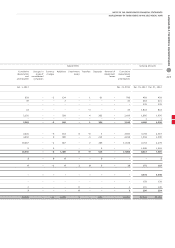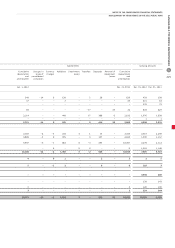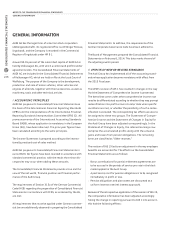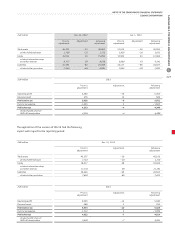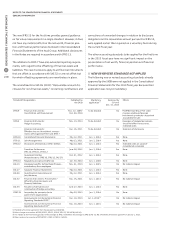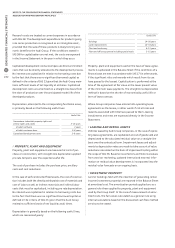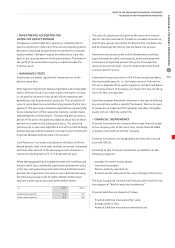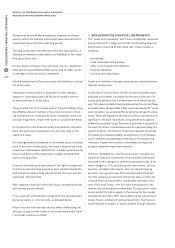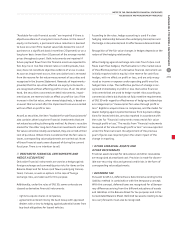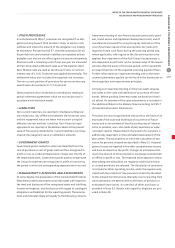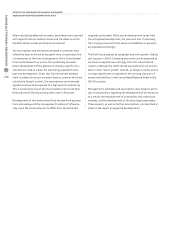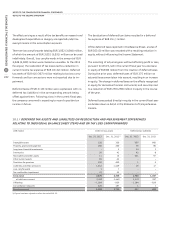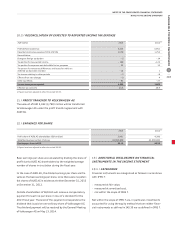Audi 2013 Annual Report Download - page 236
Download and view the complete annual report
Please find page 236 of the 2013 Audi annual report below. You can navigate through the pages in the report by either clicking on the pages listed below, or by using the keyword search tool below to find specific information within the annual report.
NOTES TO THE CONSOLIDATED FINANCIAL STATEMENTS
RECOGNITION AND MEASUREMENT PRINCIPLES
CONSOLIDATED FINANCIAL STATEMENTS
233
B
/
INVESTMENTS ACCOUNTED FOR
USING THE EQUITY METHOD
Companies in which AUDI AG is directly or indirectly able to
exercise significant influence on financial and operating policy
decisions (associated companies) are accounted for using the
equity method. Changes in equity are reflected on a pro rata
basis in the carrying amount of the participation. The share of
the profit of the associated company is reported under the
financial result.
/
IMPAIRMENT TESTS
Fixed assets are tested regularly for impairment as of the
balance sheet date.
With regard to impairment testing of goodwill and of intangible
assets, the Audi Group in principle reports the higher of value
in use and fair value less costs to sell of the respective cash-
generating units (brands and/or products). The calculation of
value in use is based on current planning prepared by the man-
agement. This planning is based on expectations regarding the
future development of the respective markets, market shares
and profitability of the products. The planning period covers a
period of five years. Plausible assumptions about future devel-
opment are made for the subsequent years. The planning
premises are in each case adjusted in line with current findings.
Appropriate assumptions based on macroeconomic trends and
historical developments are taken into account.
Cash flows are in principle calculated on the basis of the ex-
pected growth rates in the sales markets concerned. Estimated
cash flow after the end of the planning period is based on a
maximum rate of growth of 1.5 (1.5) percent per year.
When testing goodwill and intangible assets with indefinite and
limited useful lives, essentially capitalized development costs,
in the two cash generating units Automotive and Motorcycles
business for impairment, the value in use is determined using
the following average costs of capital (WACC) before taxes
(with prior-year figures also now stated before taxes):
%
2013 2012
Automotive segment 6.6 6.6
Motorcycles segment 8.1 8.8
The costs of capital are calculated on the basis of an interest
rate for risk-free investments. As well as a market risk premium,
specific peer group information for beta factors, the debt ratio
and borrowed capital interest rate are taken into account.
Impairment tests are carried out for development activities,
acquired property rights, and property, plant and equipment
on the basis of expected product life cycles, the respective
revenue and cost situation, current market expectations and
currency-specific factors.
Impairment losses pursuant to IAS 36 are recognized where
the recoverable amount, i.e. the higher amount from either
the use or disposal of the asset in question, has declined below
its carrying amount. If necessary, an impairment loss resulting
from this test is recognized.
Sensitivity analyses have shown that even in the case of differing
key assumptions within a realistic framework, there is no need
to recognize an impairment for goodwill and other intangible
assets with an indefinite useful life.
/
FINANCIAL INSTRUMENTS
Financial instruments are contracts that create financial assets
at one company and, at the same time, create financial debts
or equity instruments at another company.
Financial instruments are recognized and measured in accord-
ance with IAS 39.
According to this, financial instruments are divided into the
following categories:
>available-for-sale financial assets,
>loans and receivables,
>held-to-maturity investments,
>financial assets measured at fair value through profit or loss.
The Audi Group does not have any financial assets that fall into
the category of “held-to-maturity investments.”
Financial liabilities are classed as follows:
>financial liabilities measured at fair value
through profit or loss,
>financial liabilities measured at amortized cost.


